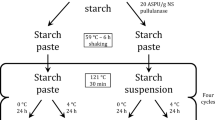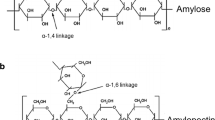Abstract
Rice varieties such as IR-20, Ponni, Bhavani and IR-50 that are preferred for cooking showed larger surface area, higher water uptake at 96°C, greater cooked volume, soft gel consistency and greater elongation ratio. Rice varieties which are exclusively used for makingidli anddosai exhibited lower protein content, medium alkali score and higher percentage of total as well as soluble starch and amylopectin. Rice varieties which are used for making flakes showed hard gel consistency, higher alkali digestibility values, lower soluble amylose content and relatively higher amount of hot water-soluble reducing sugars. Varieties used for making puffed rice do not show any specific characteristics to differentiate them from the above types. All the rice varieties studied belong to the high amylose group except ASD-1 which belongs to the medium amylose group.
Similar content being viewed by others
References
Ananthachar TK, Narasimha HV, Shankara R, Gopal MS, Desikachar HSR (1982) Improvement of traditional process for rice flakes, J Food Sci Tech 19:47–50
Antonio AA, Juliano BO (1973) Amylose content and puffed volume of parboiled rice. J Food Sci 38:915–916
Bhattacharya KR, Sowbhagya CM (1971) Water uptake by rice during cooking. Cereal Sci Today 16:420–424
Bhattacharya KR, Sowbhagya CM (1980) Size and shape classification of rice. IL RISO. 29:181–184
Cagampang GB, Perez CM, Juliano BO (1973) A gel consistency test for eating quality of rice. J Sci Food Agric 24:1589–1594
Clegg KM (1956) The application of the anthrone reagent to the estimation of starch in cereals. J Sci Food Agric 7:40–44
International Rice Research Institute (1983) Annual report for 1981 Los Banos, Philippines, pp 21–34
Juliano BO (1979) Amylose analysis in rice-A review. In proceeding of the workshop on chemical aspects of rice grain quality. International Rice Research Institute, Philippines, pp 251–260
Juliano BO (1979) The chemical basis of rice grain quality. In proceedings of the workshop on chemical aspects of rice grain quality. International Rice Research Institute, Philippines, pp 69–90
Little RR, Hilder GB, Dawson EH (1958) Differential effect of dilute alkali on 25 varieties of milled white rice. Cereal chem 35:111–126
Lowry OH, Rosenbrough NJ, Farr AL, Randall RJ (1951) Protein measurement with Folin Phenol reagent. J Biol chem 193:268–275
Nelson N (1944) A Photometric adaptation for the Somogyi method for the determination of glucose. J Biol Chem 153:375–380
Raghavendra Rao SN, Juliano BO (1970) Effect of parboiling on some physicochemical properties of rice. J Agric Food Chem 18:289–294
Srinivas T, Lakshmi TK, Desikachar HSR (1974) Varietal differences in puffing quality of paddy. J Food Sci Tech 11:134–135
Zakiuddin Ali, Bhattacharya KR (1972) Hydration and amylose solubility behaviour of parboiled rice. Food Sci + Technol 5:207–212
Author information
Authors and Affiliations
Rights and permissions
About this article
Cite this article
Thayumanavan, B., Sadasivam, S. Physicohemical basis for the preferential uses of certain rice varieties. Plant Food Hum Nutr 34, 253–259 (1984). https://doi.org/10.1007/BF01126554
Received:
Revised:
Issue Date:
DOI: https://doi.org/10.1007/BF01126554




